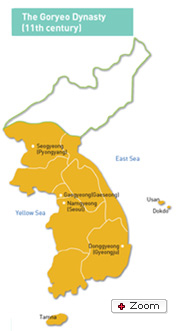
map of Goryeo Dynastry (11th century)
The Goryeo Dynasty (918-1392) was founded by Wang Geon, a general who had served under Gungye, a rebel prince of the Silla Kingdom. Choosing his native town of Songak (present-day Gaeseong in North Korea) as the capital, Wang Geon proclaimed the goal of recovering the lost territory of the Goguryeo Kingdom in northeast China.
Wang Geon named his dynasty Goryeo, from which the modern name Korea is derived. Although the Goryeo Dynasty could not reclaim lost lands, it achieved a sophisticated culture represented by cheongja or blue-green celadon and flourishing Buddhist tradition.
No less significant was the invention of the world's first movable metal type in 1234, which preceded the Gutenberg Bible of Germany by two centuries. About that time, skilled Korean artisans also completed the herculean task of carving the entire Buddhist canon on large woodblocks.
These woodblocks, numbering more than 80,000, were intended to invoke the influence of Buddha for the repulsion of the Mongol invaders. Called the Tripitaka Koreana, they are now stored at the historic Haeinsa Temple.